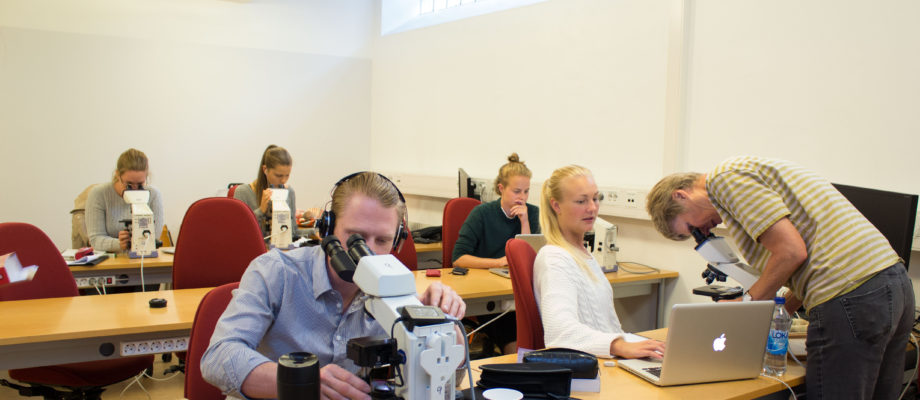EDUCATION. Sahlgrenska Academy’s teaching award goes to Eva Jennische and her colleagues at the Institute of Biomedicine. Together with their students, they have developed videos that show histological slides magnified, videos that are always available for students online. The explanation for the award notes that this is an excellent example of how digital tools can be used for educational course development.

“It is wonderful that we are being recognized with the teaching award, especially since it involves histology, which is perceived as such a traditional subject,” says Eva Jennische, professor at the Department of Medical Biochemistry and Cell Biology, who is part of the teaching team that worked to produce the videos now being recognized.
A group of students are studying histological slides in a group study room in a basement. Thinly sliced tissue samples stained using different techniques to make cells and other structures visible are studied under the microscope. In their course Histology, students will learn to recognize which organs the histologic samples come from. The course is a traditional mainstay of the medical program.
Nowadays, the practical work at the microscope includes modern tools: in a series of short videos available on GUL, students can follow how their teachers examine and describe the same samples.

“The videos are a good help,” says Alice Lidemar, one of the students at the microscope in the group room. “We can watch the videos while working on the microscopes or at home when we are studying. It’s hard to just read about the topic. Moving images are a great supplement.”

The videos serve as mini-lessons, where the teacher guides the student through the histological slides. The histology course is provided to medical students in their second semester, and the teaching team has produced the videos over time. So far, there are 40 videos available on GUL, and two more remain before the video series is complete. Each video takes about half a day to produce.
“The idea to record videos originally came from the students themselves, and we applied for funds so that we could purchase the necessary equipment. In the beginning, we considered hiring someone to narrate the videos, but concluded that it is more personal if the teachers explain what is visible in the microscope. The students do not seem to mind if we clear our throats or lose our train of thought sometimes,” says Eva Jennische, who was originally worried the videos would lead to fewer students attending the instructor-led microscopy lessons. “They attend the same as before, but now with the videos on their computers or their phones, and they listen with headphones while they are studying the sample under the microscope. Other universities have shown interest in the videos, but unclear copyright issues have prevented sharing to this point. When pathologists need to study tissue samples, the sample is now scanned and the pathologist studies it on a screen. But using a microscope serves an important educational purpose.”
“To manually set the magnification and be able to view different levels of the slides provides students a good sense of how everything is connected. If you just look at pictures, you do not understand how big things are and how they are connected in relation to each other. In addition, most of the students think it is fun.”
The teaching team being recognized consists of Eva Jennische, Levent Akyürek, Per Lindahl, Mats Sandberg, Ruth Palmer, Anne Uv and Henrik Svensson, all from the Institute of Biomedicine. Sahlgrenska Academy’s teaching award is SEK 100,000 for their institution, which is to be used for the award-winner’s teaching efforts.
In addition to the videos, they have also developed a self-correcting test, which students can use to test their knowledge of histology.











